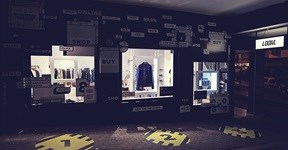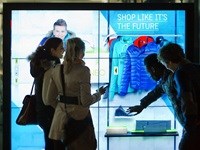Interactive window shopping not a mature concept yet?
Putting the customer at the centre of the shopping experience through customer-curated content is something that many are already trying to do. However, it seems that at this point, most of these innovative projects are taking their baby steps and do not generate actual results considering sales.
Innovation from South Africa
One attempt to create a new and intriguing way to engage customers took place in South Africa. Loom, a multibrand men's fashion store in Johannesburg and Cape Town, came up with the idea of immersive retail.
The agency behind this campaign iKineo used NFC technology, which enabled customers to manipulate certain products inside the store's window and make 24/7 purchases through a renewed mobile site. It also used RF-ID tags to tell brand stories in a new way. Loom was back on the map after the campaign, but the conversion rate was still low.
Making windows shoppable
A very similar and much praised project happened in Germany.
TBWA Helsinki realised that brands are spending a lot of money to have stores on the busiest streets. However, these stores are only open for a certain time during the day. Money is almost being thrown out the window during closing hours. The agency figured that window-shopping is missing the shopping part and, by creating an interactive window with the ability to make purchases, the brand can generate sales even when the store is closed. The fact that smartphones are no longer the second screen but the first was the key in developing an interactive shopping window.
Additional aspects had to be taken into account. People do not want to download additional apps, scan QR codes or register their personal information. As many people are passing by the window, typing in sensitive information in front of others was out of the question. Having realised all these things, the agency created an interactive touchscreen window, which was able to run all the interactions with the help of a web socket.
Finding a client
The start was difficult in the sense because there was no client of brief. It was a solution, which had to be offered to potential clients. Finland was not ready for such innovation. Building an interactive window is very expensive, because the screen has to face direct sunlight. The price for this hardware makes it something that not any retailer can afford. On the other hand, it can be used as effectively inside a shopping mall for example, where sunlight is not a problem and as a result, the price per unit is cheaper.
Adidas took the window shopping experience on board as it had just launched a new line called Neo, directed to younger clients for whom smartphones are essential part of their lives.
The pilot
Adidas window-shopping piloted in Nuremberg - a relatively small city in Germany with the population of 510,000 people. The campaign ran for six weeks.
The digital interactive concept with a touchscreen enabled people to browse products, try them on life size models, manipulate the models to do cool motions and, most importantly buy the products. There was no need for downloading an app; a simple PIN connected the window and the phone.
By visiting a simple URL via their smartphone and typing in a one-time PIN, the shoppers' mobile became interlinked in real time with a shopping bag on the window. 85% coverage of all smartphones brought in more interest. As shopping remains a social activity adidas window-shopping allowed people to share their favourite items via social networks.
Awareness as the result
People loved the window - it seemed new and intriguing. If somebody was playing with the window, it got 90% of the streets attention and 25% entered the store afterwards. The engagement rate for such a small town was very high. Still, the overall conversion rate was insignificant. Consumers were not making more purchases.
First steps
What Loom's immersive retail and adidas interactive window proved was that people are not ready yet to change their purchasing methods.
Innovation brings attractiveness and interest but the sales are not there. Campaigns like this are essential for research and development. They are the first steps towards the future, but it takes time to figure out the best way to integrate new technology and for people to get used to it.
View Loom ad
View adidas ad
Best Marketing is a European research firm that collects and analyses digital marketing case studies. www.best-marketing.eu

